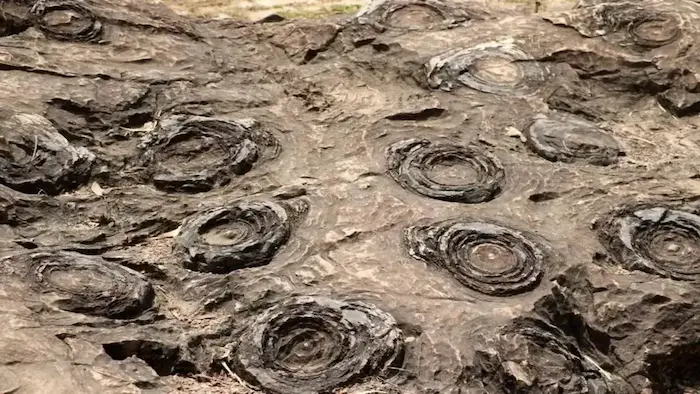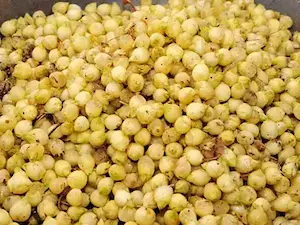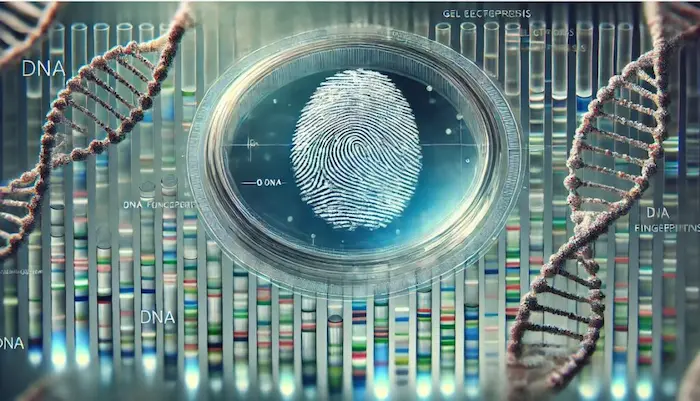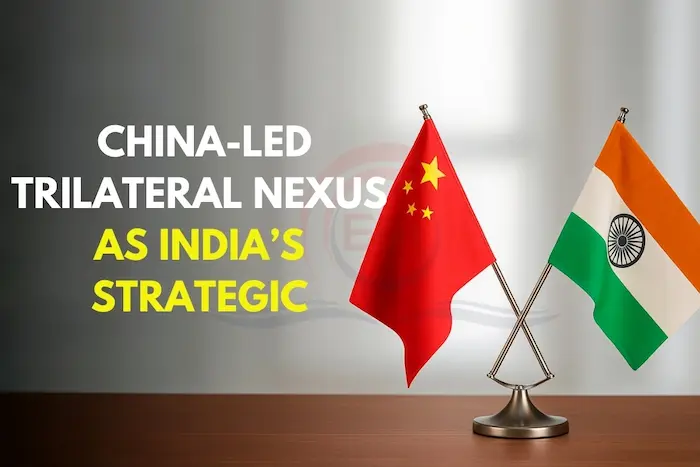1. UP’s Salkhan Fossil Park Makes It to UNESCO Tentative List – History & Culture

Why in News?
Salkhan Fossil Park, located in Uttar Pradesh, has been recently included in UNESCO’s Tentative List of World Heritage Sites, signifying its scientific and geological importance on a global scale.
Key Takeaways
Location
- Salkhan village, Sonbhadra district, Uttar Pradesh
- Lies within Kaimoor Wildlife Sanctuary, adding ecological significance
Fossil Significance
- Contains stromatolite fossils – ancient layered structures formed by cyanobacteria (photosynthetic microorganisms)
- Stromatolites are considered among the earliest evidence of life on Earth
Geological Age
- Fossils date back to 1.4 billion years (Mesoproterozoic Era)
- Found in Bhander limestone, part of the Vindhyan Supergroup
Scientific Importance
- Represents one of the richest Proterozoic rock formations globally
- Provides insights into early microbial life and Earth’s biosphere development
Ecological Context
- Situated inside a protected area (Kaimoor Wildlife Sanctuary)
- Enhances opportunities for eco-tourism and conservation education
UNESCO Tentative List: Key Details
- Tentative List: An official inventory of sites a country intends to nominate for World Heritage status
- Sites must stay on this list for at least one year before formal nomination
- Assessed based on natural, cultural, or mixed heritage value
- India’s Current Status (June 2025):
- 63 sites on Tentative List
- Includes diverse monuments, landscapes, biospheres
Benefits of Inclusion
- Promotes international recognition
- Facilitates funding for conservation
- Enhances tourism and local economic development
- Fosters scientific research and awareness
Summary
The inclusion of Salkhan Fossil Park in UNESCO’s Tentative List highlights its immense value in understanding early life on Earth, particularly through its well-preserved stromatolite fossils. Situated in a biodiverse region of Uttar Pradesh, the park exemplifies the intersection of geological heritage and environmental conservation. This global recognition is expected to boost scientific interest, tourism, and heritage preservation efforts in India.
Exam Connect – Possible Questions
Prelims
- Which of the following fossils found in Salkhan Fossil Park provide evidence of early microbial life?
A. Trilobites
B. Stromatolites
C. Ammonites
D. Graptolites
Answer: B. Stromatolites - Salkhan Fossil Park is situated in which of the following Indian states?
A) Madhya Pradesh
B) Rajasthan
C) Uttar Pradesh
D) Bihar
Answer: C. Uttar Pradesh - Which geological formation hosts the fossils found in Salkhan Fossil Park?
A. Aravalli Range
B. Deccan Traps
C. Vindhyan Supergroup
D. Siwalik Hills
Answer: C. Vindhyan Supergroup
Mains
- “Stromatolite fossils in India not only provide evidence of early life but also highlight the importance of geological heritage in national identity and conservation.” Discuss with reference to Salkhan Fossil Park.
- “Inclusion in UNESCO’s Tentative List is a strategic step in heritage management.” Evaluate the implications of this status for fossil parks and natural heritage sites in India.
2. Mahua: The Lifeline of Central India’s Tribal Communities – Environment

Why in News?
The Mahua tree (Madhuca longifolia) has gained attention for its critical role in the cultural, economic, and ecological life of tribal communities in Central India. Recent innovations such as the Mahua Nutra Beverage, supported by TRIFED and FIIT, aim to promote value addition and sustainable livelihoods.
Key Takeaways
Botanical Overview
- Medium-sized deciduous tree, 16–20 metres tall
- Identified by creamy-white flowers, blooming in March-April
- Grows widely across:
- Jharkhand, Chhattisgarh, Odisha, Bihar, West Bengal
- Maharashtra, Gujarat, Telangana, Tamil Nadu, Kerala
Cultural and Religious Importance
- Revered as the “Tree of Life” among tribal groups
- Used in rituals, offerings, and even funeral rites
- Deeply embedded in tribal oral traditions and customs
Nutritional & Economic Role
- Flowers consumed raw or sun-dried; rich in nutrients
- Fermented into alcohol, forming an essential part of local diets and economy
- Supports food security and livelihoods, especially for tribal women
- Collection, drying, fermentation, and sale form an informal village-level industry
Ecological Significance
- Mahua flowers attract bats, insects, and sloth bears – promoting pollination and seed dispersal
- Vital for the health of forest ecosystems
- Human-wildlife conflict over Mahua (e.g., with sloth bears) reflects its ecological demand
Innovation & Value Addition
- Mahua Nutra Beverage:
- Developed by TRIFED (Tribal Cooperative Marketing Development Federation) & FIIT (Foundation for Innovation and Technology Transfer)
- First-of-its-kind initiative in Jharkhand and India
- Aims to enhance tribal income, improve nutritional value, and build market linkages
Summary
Mahua is not merely a tree—it is a cultural symbol, nutritional source, and economic backbone for many tribal communities across India. Its flowers fuel local economies and rituals, while also playing an essential role in the ecological balance of forest systems. With modern efforts such as the Mahua Nutra Beverage, the integration of traditional knowledge with scientific innovation is creating sustainable development models that empower tribal populations and conserve biodiversity.
Exam Connect – Possible Questions
Prelims
- Mahua tree, recently in news, is botanically known as:
A. Azadirachta indica
B. Madhuca longifolia
C. Butea monosperma
D. Shorea robusta
Answer: B. Madhuca longifolia - Which of the following is not associated with Mahua tree?
A. It blooms during winter
B. Its flowers are used in fermentation
C. It supports tribal livelihoods
D. It is found in Chhattisgarh and Jharkhand
Answer: A. It blooms during winter - TRIFED and FIIT are collaborating on which innovation related to tribal welfare?
A. Millet Revival Programme
B. Bamboo Livelihood Scheme
C. Mahua Nutra Beverage
D. Tribal e-Market Portal
Answer: C. Mahua Nutra Beverage
Mains
- “The Mahua tree is a key component of tribal ecology, culture, and economy.” Discuss its multidimensional significance and examine the role of value-added innovations in improving tribal livelihoods.
- “Sustainable tribal development requires the integration of traditional knowledge with modern technology.” Analyze with reference to the Mahua Nutra Beverage initiative.
3. Revamped Sugamya Bharat App: Promoting Accessibility for All – Governance
Why in News?
The Sugamya Bharat App (SBA) has recently undergone a major revamp to improve user experience and extend its impact on accessibility for persons with disabilities (divyangjan) and senior citizens. This aligns with India’s commitment to inclusive governance under the Accessible India Campaign.
Key Takeaways
About the App
- Launched: 2021
- Implementing Agency: Department of Empowerment of Persons with Disabilities (DEPwD)
- Ministry: Union Ministry of Social Justice and Empowerment
- Revamped in 2025 to improve interface, responsiveness, and outreach
Core Functions
- Enables users to report accessibility barriers in:
- Public buildings
- Transport systems
- Information and Communication Technology (ICT) – including websites and TV
- Reports include geo-tagged photos to help authorities identify and act on issues quickly
- Features a real-time AI chatbot for instant help and feedback
- Available in 10 Indian languages, making it linguistically inclusive
Accessibility Enhancement Features
- Integrates with government welfare schemes (e.g., accessible toilets, ramps, audio-visual aids)
- Functions as a one-stop platform for resources, rights, and grievance redressal
- Helps in mapping and improving public infrastructure for universal access
Summary
The revamped Sugamya Bharat App reflects India’s evolving approach to inclusive and accessible governance. By integrating technology with public policy, the app empowers persons with disabilities and senior citizens to actively participate in identifying and resolving accessibility barriers. It is a key enabler of rights-based service delivery and strengthens India’s journey toward becoming a truly inclusive society.
Exam Connect – Possible Questions
Prelims
- Which ministry is responsible for implementing the Sugamya Bharat App?
A. Ministry of Electronics and IT
B. Ministry of Home Affairs
C. Ministry of Social Justice and Empowerment
D. Ministry of Health and Family Welfare
Answer: C. Ministry of Social Justice and Empowerment - Which of the following features is not part of the revamped Sugamya Bharat App?
A. Geo-tagged complaint reporting
B. AI-powered chatbot
C. Online booking for hospitals
D. Multilingual support
Answer: C. Online booking for hospitals - Sugamya Bharat App primarily aims to:
A. Promote digital literacy among youth
B. Improve accessibility for persons with disabilities
C. Provide employment to rural artisans
D. Digitize land records
Answer: B. Improve accessibility for persons with disabilities
Mains
- “The true test of good governance lies in how it empowers the most vulnerable.” Critically examine this statement in the context of the Sugamya Bharat App and India’s approach to accessibility.
- Discuss the role of digital applications in promoting inclusive governance in India. Use examples such as the Sugamya Bharat App to support your answer.
4. DNA Polymorphism and Fingerprinting in Forensic Science – Science and Technology

Why in News?
In the aftermath of the tragic Air India Flight AI 171 crash on June 12, 2025, which claimed 241 lives, DNA fingerprinting played a central role in identifying the victims. The final DNA matching process was completed recently, following symbolic funeral ceremonies held by the victims’ families.
Key Scientific Concepts
What is DNA?
- DNA (Deoxyribonucleic Acid) is the hereditary material found in almost every cell of the human body (e.g., blood, skin, bone, teeth).
- Humans have 46 chromosomes (23 pairs)—half from each parent.
- These chromosomes contain genes, which govern physical traits and biological identity.
DNA Polymorphism
- Polymorphism refers to variations in DNA sequences between individuals.
- These variations are unique to each person, making them valuable for:
- Forensic identification
- Parentage determination
- Genealogy tracing
Short Tandem Repeats (STRs)
- STRs are short, repeating sequences of DNA bases (e.g., GATC-GATC).
- Each person has a distinct STR pattern, even among siblings (except identical twins).
- STRs are critical for:
- Criminal investigations
- Victim identification
- Ancestry and paternity testing
Polymerase Chain Reaction (PCR) – DNA Amplification
Used when only small amounts of DNA are available.
Steps:
- Extraction – DNA is isolated from bones, blood, or tissue.
- Denaturation (95°C) – DNA strands are separated.
- Annealing (60°C) – Primers attach to specific target sequences.
- Extension (72°C) – DNA polymerase synthesizes new strands.
- Repetition – The cycle is repeated ~30–40 times to generate millions of copies.
DNA Fingerprinting
- A method of creating a unique genetic profile based on STR variations
- Involves capillary electrophoresis – an electric current separates DNA fragments by size
- DNA fingerprinting can use samples from:
- Blood, saliva, bone, teeth, skin cells, sweat, semen
Summary
DNA polymorphism refers to unique differences in DNA sequences among individuals. DNA fingerprinting, based on STR markers and PCR amplification, is now central to forensic science. Its use in identifying victims of the Air India crash exemplifies how genetic technologies aid disaster response, justice, and humanitarian services. With ethical safeguards, such tools are vital for modern public administration and emergency management.
Exam Connect – Possible Questions
Prelims
- DNA fingerprinting is primarily based on which of the following genetic markers?
A. Single nucleotide polymorphisms
B. Short Tandem Repeats (STRs)
C. Ribosomal RNA sequences
D. Mitochondrial genes
Answer: B. Short Tandem Repeats (STRs) - Which of the following steps is not part of the Polymerase Chain Reaction (PCR)?
A. Denaturation
B. Replication
C. Annealing
D. Extension
Answer: B. Replication - Which statement is true about DNA fingerprinting?
A. It cannot be used if DNA is extracted from bones.
B. It is only accurate in paternity testing.
C. Identical twins can be differentiated using STR-based fingerprinting.
D. It provides a unique profile for each individual, except identical twins.
Answer: D. It provides a unique profile for each individual, except identical twins.
Mains
- “DNA fingerprinting has revolutionized forensic science and disaster management.” Discuss with reference to recent events and the role of biotechnology in governance.
- Explain the role of Polymerase Chain Reaction (PCR) and Short Tandem Repeats (STRs) in forensic DNA analysis. Highlight ethical concerns that may arise from the use of such technologies.
5. Statistics Day 2025 – Celebrating Data-Driven Governance – Governance

Why in News?
The Ministry of Statistics and Programme Implementation (MoSPI) celebrated the 19th Statistics Day on June 29, 2025, in New Delhi to commemorate the birth anniversary of Prof. Prasanta Chandra Mahalanobis, a pioneer of statistics in India. The 2025 theme highlights “75 Years of the National Sample Survey (NSS)”.
Key Takeaways
About Statistics Day
- Observed: Annually on June 29
- Started: In 2006 by the Government of India
- Purpose:
- To raise awareness about the importance of statistics in evidence-based policy, planning, and governance
- Encourage young minds to engage with statistical methods for development work
Theme for 2025
- “75 Years of National Sample Survey”
- Recognizes the National Sample Survey Office (NSSO) for providing reliable socio-economic data used in policymaking, especially in areas like:
- Poverty estimation
- Employment/unemployment
- Health & education statistics
About Prof. P.C. Mahalanobis
| Aspect | Details |
|---|---|
| Born | June 29, 1893 |
| Known As | Father of Indian Statistics |
| Key Contribution | Developed the Mahalanobis Distance, a measure used in multivariate statistical analysis |
| Institution Builder | Founded Indian Statistical Institute (ISI) in 1931 |
| Planning Role | Member of the First Planning Commission; architect of India’s Five-Year Plans |
| Awards | Padma Vibhushan for contributions to science and statistics |
| Legacy | Strong advocate of data-based decision making in governance |
Global Perspective
- World Statistics Day: Celebrated every five years on October 20 by the United Nations
- Emphasizes the global importance of statistical systems for sustainable development
Summary
Statistics Day 2025, centered around the theme “75 Years of National Sample Survey”, celebrates the monumental contributions of Prof. P.C. Mahalanobis to India’s planning process and the development of scientific statistical methods. By promoting data-driven governance, this day underscores the growing significance of statistics in public administration, policy formulation, and nation-building.
Exam Connect – Possible Questions
Prelims
- Statistics Day is observed in India on which date?
A. June 15
B. June 29
C. October 20
D. July 1
Answer: B. June 29 - Who among the following is known as the ‘Father of Indian Statistics’?
A. V.K.R.V. Rao
B. P.C. Mahalanobis
C. Amartya Sen
D. Meghnad Saha
Answer: B. P.C. Mahalanobis - The Mahalanobis Distance is used in:
A. Quantum physics
B. Multivariate statistics
C. National accounting
D. Thermodynamics
Answer: B. Multivariate statistics - Which of the following statements is correct about the National Sample Survey (NSS)?
A. It is conducted every year by NITI Aayog
B. It collects only agricultural data
C. It is a major socio-economic survey mechanism under MoSPI
D. It is conducted by the Ministry of Agriculture
Answer: C. It is a major socio-economic survey mechanism under MoSPI
Mains
- “Effective governance requires a robust statistical system.” Discuss the role of the National Sample Survey and the contributions of Prof. P.C. Mahalanobis in shaping India’s statistical landscape.
- Discuss how celebrations like Statistics Day help promote evidence-based policymaking and data literacy in governance
- Explain the significance of statistical tools like the Mahalanobis Distance in modern economic planning and social development
6. Practicing Equality in Constitutional Courts: Re-examining the Senior Advocate Designation System – Polity

Why in News?
On May 13, 2025, the Supreme Court of India delivered a noteworthy judgment concerning the designation of senior advocates, sparking debate about elitism, subjectivity, and inequality in the legal profession. Though seen as an internal matter of the court, the judgment raised broader constitutional concerns related to Article 14 (Right to Equality).
Key Takeaways
Section 16 of the Advocates Act, 1961
- Allows classification of advocates into:
- Senior Advocates
- Other Advocates
- Based on “ability”, “experience”, and “standing at the Bar”—terms that lack objective benchmarks
- Raises potential conflict with Article 14, as it may create arbitrary distinctions among equals
Supreme Court Rules, 2013 – Procedural Issues
- Order IV, Rule 2 grants pre-audience rights and special privileges to senior advocates
- Current point-based evaluation allows subjective discretion of judges
- This may foster favoritism and undermine transparency
2025 Jitender Judgment – Missed Opportunity
- Acknowledged flaws in the current system but:
- Did not examine the constitutional validity of Section 16
- Did not refer the matter to a larger bench for scrutiny
- Maintained application-based process, retaining judicial discretion
- Delegated reforms to High Courts, without systemic changes
Why This Matters – Broader Concerns of Inequality
| Challenge | Explanation |
|---|---|
| Access to Legal Education | Rural/low-income students face language barriers, high costs, and lack of access to elite law schools |
| Urban Bias | Lawyers in metro cities get more visibility; those from smaller towns often overlooked |
| Underrepresentation | Women, Dalits, and lawyers from marginalized communities are disproportionately excluded from designation |
| Favoritism in Designation | Lawyers known to judges are more likely to be designated; merit is often secondary |
Way Forward – Reforms for Inclusion and Equality
Transparent Designation Process
- Establish objective, merit-based criteria for senior advocate designation
- Include diverse and independent selection panels (including women, SC/ST, and OBC members)
- Ensure public disclosure of selection results and criteria
Legal Education Reform
- Expand scholarships, regional law schools, and vernacular-language instruction
- Support skill development and internship opportunities for rural and underprivileged students
Judicial Accountability
- Regularly review court practices for bias or exclusion
- Introduce mechanisms for grievance redressal in designation-related decisions
Summary
The 2025 Supreme Court judgment on senior advocate designation has reopened vital discussions on judicial elitism, opaque processes, and inclusiveness in legal institutions. Despite recognizing subjectivity, the Court failed to question the constitutional legitimacy of Section 16 of the Advocates Act. This reflects a missed opportunity to promote systemic reform, especially for women, Dalits, and rural lawyers. A transparent, inclusive, and merit-based system is the need of the hour to uphold constitutional values and democratic access to justice.
Exam Connect – Possible Questions
Prelims
- Which section of the Advocates Act, 1961 deals with the classification of senior advocates?
A. Section 14
B. Section 16
C. Section 21
D. Section 24
Answer: B) Section 16 - Which constitutional article is primarily invoked in cases related to equality before law?
A. Article 19
B. Article 21
C. Article 32
D. Article 14
Answer: D. Article 14 - In which case did the Supreme Court uphold the validity of senior advocate designation rules in 2017?
A. M.C. Mehta v. Union of India
B. Indira Jaising v. Supreme Court of India
C. Kesavananda Bharati v. State of Kerala
D. Shreya Singhal v. Union of India
Answer: B. Indira Jaising v. Supreme Court of India
Mains
- “Equality before law is meaningless if access to justice remains unequal.” Examine the challenges posed by the current senior advocate designation system in light of Article 14 of the Constitution.
- Discuss the need for judicial reform to make the legal profession more inclusive and transparent. In your answer, highlight the issues raised in the 2025 Supreme Court judgment on senior advocate designation.
- “Justice must not only be done, it must also be seen to be inclusive.” Analyze this statement with reference to the structure and practices of India’s higher judiciary.
7. A China-led Trilateral Nexus: A Strategic Challenge for India in South Asia – International Relations

Why in News?
China recently hosted its first-ever trilateral dialogue with Pakistan and Bangladesh in Kunming, following a similar engagement with Pakistan and Afghanistan. These moves are part of China’s growing strategic outreach in South Asia, aiming to revive Pakistan’s regional relevance and counterbalance India’s influence.
Key Takeaways
China’s Strategic Objectives
- Expand regional influence by leveraging its strong ties with Pakistan
- Exploit India’s bilateral frictions with neighboring countries (e.g., Bangladesh, Afghanistan)
- Promote China-led forums as alternatives to India-centric platforms like SAARC and BIMSTEC
- Reinforce its “Belt and Road Initiative (BRI)” and China-Pakistan Economic Corridor (CPEC) strategies through trilateral engagements
China–Pakistan Nexus: A Longstanding Strategic Alliance
| Area | Key Facts |
|---|---|
| Strategic Bond | Cemented post-1962 India-China war; includes deep military and diplomatic coordination |
| Economic Ties | By end of 2024, Pakistan’s debt to China exceeded $29 billion |
| Military Ties | Over 80% of Pakistan’s arms imports come from China |
| Diplomatic Backing | China regularly defends Pakistan in UN forums on terrorism and Kashmir issues |
Recent Flashpoint: Operation Sindoor (2025)
- Launched by India in response to Pahalgam terror attack
- Criticized by China as “regrettable”, while backing Pakistan’s demand for an international investigation
- Sparked renewed diplomatic tension, with China using this to deepen engagement with Pakistan
Post-Conflict Trilateral Diplomacy
- China-Pakistan-Afghanistan and China-Pakistan-Bangladesh trilaterals show China’s push to:
- Reposition Pakistan as a regional interlocutor
- Present China as a peace-building power
- Shift geopolitical influence away from India
India’s Strategic Response
- Since Uri (2016), Pulwama (2019), and Pahalgam (2025), India has adopted a more assertive military and diplomatic posture
- Launched operations like Surgical Strikes, Balakot Airstrike, and Operation Sindoor
- Diplomatic Isolation Strategy: Actively counters Pakistan in international forums and strengthens bilateral ties with like-minded nations (e.g., Japan, US, France)
Summary
China’s strategic move to lead trilateral talks with Pakistan and regional nations like Bangladesh and Afghanistan signifies a deeper challenge to India’s traditional sphere of influence. Through these dialogues, China seeks to reassert its dominance, revive Pakistan’s role, and dilute India’s regional standing. India’s response must include proactive diplomacy, regional economic engagement, and strong defense posturing to counterbalance China’s growing assertiveness.
Exam Connect – Possible Questions
Prelims
- Which of the following countries participated in China’s first trilateral meeting in Kunming in 2025?
A. China, Pakistan, Afghanistan
B. China, Pakistan, Bangladesh
C. China, India, Nepal
D. China, Myanmar, Bhutan
Answer: B. China, Pakistan, Bangladesh - The China-Pakistan Economic Corridor (CPEC) primarily passes through which region disputed by India?
A. Sikkim
B. Aksai Chin
C. Gilgit-Baltistan
D. Arunachal Pradesh
Answer: C. Gilgit-Baltistan - Which operation was launched by India in response to the Pahalgam terror attack in May 2025?
A. Operation Meghdoot
B. Operation Sindoor
C. Operation Shakti
D. Operation Surya
Answer: B. Operation Sindoor
Mains
- “China’s trilateral diplomacy in South Asia is reshaping regional dynamics.” Discuss how China’s strategic engagements with Pakistan and other South Asian nations affect India’s foreign policy and security calculus.
- Evaluate India’s foreign policy response to the emerging China-Pakistan nexus. In your answer, highlight the importance of regional diplomacy and internal security preparedness.
- “The neighborhood first policy must evolve to counter neighborhood-first challenges.” Analyze in the context of China’s expanding trilateral engagements in South Asia.

